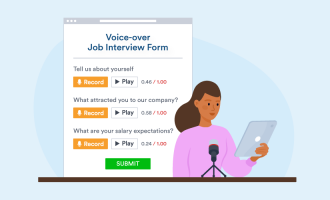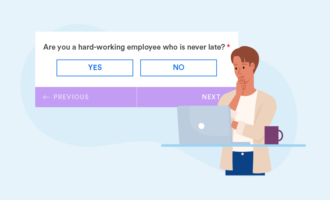Whether you’re collecting data for business or academic research, the first step is to identify the type of data you need to collect and what method you’ll use to do so. In general, there are two data types — primary and secondary — and you can gather both with a variety of effective collection methods.
Primary data refers to original, firsthand information, while secondary data refers to information retrieved from already existing sources. Peter Drow, head of marketing at NCCuttingTools, explains that “original findings are primary data, whereas secondary data refers to information that has already been reported in secondary sources, such as books, newspapers, periodicals, magazines, web portals, etc.”
Both primary and secondary data-collection methods have their pros, cons, and particular use cases. Read on for an explanation of your options and a list of some of the best methods to consider.
Primary data-collection methods
As mentioned above, primary data collection involves gathering original and firsthand source information. Primary data-collection methods help researchers or service providers obtain specific and up-to-date information about their research subjects. These methods involve reaching out to a targeted group of people and sourcing data from them through surveys, interviews, observations, experiments, etc.
You can collect primary data using quantitative or qualitative methods. Let’s take a closer look at the two:
Quantitative data-collection methods involve collecting information that you can analyze numerically. Closed-ended surveys and questionnaires with predefined options are usually the ways researchers collect quantitative information. They can then analyze the results using mathematical calculations such as means, modes, and grouped frequencies. An example is a simple poll. It’s easy to quickly determine or express the number of participants who choose a specific option as a percentage of the whole.
Qualitative data collection involves retrieving nonmathematical data from primary sources. Unlike quantitative data-collection methods where subjects are limited to predefined options, qualitative data-collection methods give subjects a chance to freely express their thoughts about the research topic. As a result, the data researchers collect via these methods is unstructured and often nonquantifiable.
Here’s an important difference between the two: While quantitative methods focus on understanding “what,” “who,” or “how much,” qualitative methods focus on understanding “why” and “how.” For example, quantitative research on parents may show trends that are specific to fathers or mothers, but it may not uncover why those trends exist.
Drow explains that applying quantitative methods is faster and cheaper than applying qualitative methods. “It is simple to compare results because quantitative approaches are highly standardized. In contrast, qualitative research techniques rely on words, sounds, feelings, emotions, colors, and other intangible components.”
Drow emphasizes that the field of your study and the goals and objectives of your research will influence your decision about whether to use quantitative or qualitative methodologies for data collection.
Below are some examples of primary data-collection methods:
1. Questionnaires and surveys
While researchers often use the terms “survey” and “questionnaire” interchangeably, the two mean slightly different things.
A questionnaire refers specifically to the set of questions researchers use to collect information from respondents. It may include closed-ended questions, which means respondents are limited to predefined answers, or open-ended questions, which allow respondents to give their own answers.
A survey includes the entire process of creating questionnaires, collecting responses, and analyzing the results.
Jotform’s free survey maker makes it easy to conduct surveys. Using any of Jotform’s customizable survey templates, you can quickly create a questionnaire and share your survey with respondents using a shareable link. You can also analyze survey results in easy-to-read spreadsheets, charts, and more.
2. Interviews
An interview is a conversation in which one participant asks questions and the other provides answers. Interviews work best for small groups and help you understand the opinions and feelings of respondents.
Interviews may be structured or unstructured. Structured interviews are similar to questionnaires and involve asking predetermined questions with specific multiple-choice answers. Unstructured interviews, on the other hand, give subjects the freedom to provide their own answers. You can conduct interviews in person or via recorded video or audio conferencing.
3. Focus groups
A focus group is a small group of people who have an informal discussion about a particular topic, product, or idea. The researcher selects participants with similar interests, gives them topics to discuss, and records what they say.
Focus groups can help you better understand the results of a large-group quantitative study. For example, a survey of 1,000 respondents may help you spot trends and patterns, but a focus group of 10 respondents will provide additional context for the results of the large-group survey.
4. Observation
Observation involves watching participants or their interactions with specific products or objects. It’s a great way to collect data from a group when they’re unwilling or unable to participate in interviews — children are a good example.
You can conduct observations covertly or overtly. The former involves discreetly observing people’s behavior without their knowledge. This allows you to see them acting naturally. On the other hand, you have to conduct overt observation openly, and it may cause the subjects to behave unnaturally.
Advantages of primary data-collection methods
- Accuracy: You collect data firsthand from the target demographic, which leaves less room for error or misreporting.
- Recency: Sourcing primary data ensures you have the most up-to-date information about the research subject.
- Control: You have full control over the data-collection process and can make adjustments where necessary to improve the quality of the data you collect.
- Relevance: You can ask specific questions that are directly relevant to your research.
- Privacy: You can control access to the research results and maintain the confidentiality of respondents.
Disadvantages of primary data collection
- Cost: Collecting primary data can be expensive, especially if you’re working with a large group.
- Labor: Collecting raw data can be labor intensive. When you’re gathering data from large groups, you need more skilled hands. And if you’re researching something arcane or unusual, it might be difficult to find people with the appropriate expertise.
- Time: Collecting primary data takes time. If you’re conducting surveys, for example, participants have to fill out questionnaires. This could take anywhere from a few days to several months, depending on the size of the study group, how you deliver the survey, and how quickly participants respond. Post-survey activities, such as organizing and cleaning data to make it usable, also add up.
Secondary data-collection methods
Secondary data collection involves retrieving already available data from sources other than the target audience. When working with secondary data, the researcher doesn’t “collect” data; instead, they consult secondary data sources.
Secondary data sources are broadly categorized into published and unpublished data. As the names suggest, published data has been published and released for public or private use, while unpublished data comprises unreleased private information that researchers or individuals have documented.
When choosing public data sources, Drow strongly recommends considering the date of publication, the author’s credentials, the source’s dependability, the text’s level of discussion and depth of analysis, and the impact it has had on the growth of the field of study.
Below are some examples of secondary data sources:
1. Online journals, records, and publications
Data that reputable organizations have collected from research is usually published online. Many of these sources are freely accessible and serve as reliable data sources. But it’s best to search for the latest editions of these publications because dated ones may provide invalid data.
2. Government records and publications
Periodically, government institutions collect data from people. The information can range from population figures to organizational records and other statistical information such as age distribution. You can usually find information like this in government libraries and use it for research purposes.
3. Business and industry records
Industries and trade organizations usually release revenue figures and periodic industry trends in quarterly or biannual publications. These records serve as viable secondary data sources since they’re industry-specific.
Previous business records, such as companies’ sales and revenue figures, can also be useful for research. While some of this information is available to the public, you may have to get permission to access other records.
4. Newspapers
Newspapers often publish data they’ve collected from their own surveys. Due to the volume of resources you’ll have to sift through, some surveys may be relevant to your niche but difficult to find on paper. Luckily, most newspapers are also published online, so looking through their online archives for specific data may be easier.
5. Unpublished sources
These include diaries, letters, reports, records, and figures belonging to private individuals; these sources aren’t in the public domain. Since authoritative bodies haven’t vetted or published the data, it can often be unreliable.
Advantages of secondary data-collection methods
Below are some of the benefits of secondary data-collection methods and their advantages over primary methods.
- Speed: Secondary data-collection methods are efficient because delayed responses and data documentation don’t factor into the process. Using secondary data, analysts can go straight into data analysis.
- Low cost: Using secondary data is easier on the budget when compared to primary data collection. Secondary data often allows you to avoid logistics and other survey expenses.
- Volume: There are thousands of published resources available for data analysis. You can sift through the data that several individual research efforts have produced to find the components that are most relevant to your needs.
- Ease of use: Secondary data, especially data that organizations and the government have published, is usually clean and organized. This makes it easy to understand and extract.
- Ease of access: It’s generally easier to source secondary data than primary data. A basic internet search can return relevant information at little or no cost.
Disadvantages of secondary data collection
- Lack of control: Using secondary data means you have no control over the survey process. Already published data may not include the questions you need answers to. This makes it difficult to find the exact data you need.
- Lack of specificity: There may not be many available reports for new industries, and government publications often have the same problems. Furthermore, if there’s no available data for the niche your service specializes in, you’ll encounter problems using secondary data.
- Lack of uniqueness: Using secondary sources may not give you the originality and uniqueness you need from data. For instance, if your service or product hinges on innovation and uses an out-of-the-norm approach to problem-solving, you may be disappointed by the generic nature of the data you collect.
- Age: Because user preferences change over time, data can evolve. The secondary data you retrieve can become invalid. When this happens, it becomes difficult to source new data without conducting a hands-on survey.
A simplified data-collection process with Jotform
Whether you’re collecting primary or secondary data, Jotform’s collection of templates makes it easier to organize and track your data. You can quickly design survey forms with Jotform’s powerful form builder. You can also create databases that allow you to easily sort, filter, and group your data. Plus, you can import data from existing sources and create stunning visual reports at the click of a button.































Send Comment:
2 Comments:
101 days ago
keep giving us quality information
More than a year ago
Nice compliment with full information.